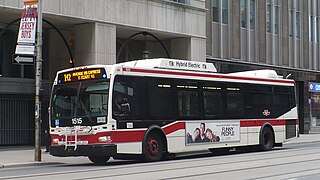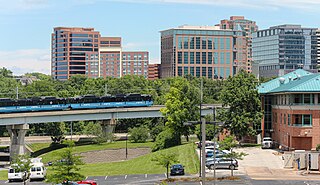Related Research Articles

The Toronto Transit Commission (TTC) is the public transport agency that operates bus, subway, streetcar, and paratransit services in Toronto, Ontario, Canada, some of which run into the Peel Region and York Region. It is the oldest and largest of the urban transit service providers in the Greater Toronto Area, with numerous connections to systems serving its surrounding municipalities.

The San Francisco Municipal Railway ( MEW-nee; SF Muni or Muni), is the primary public transit system within San Francisco, California. It operates a system of bus routes, the Muni Metro light rail system, three historic cable car lines, and two historic streetcar lines. Previously an independent agency, the San Francisco Municipal Railway merged with two other agencies in 1999 to become the San Francisco Municipal Transportation Agency (SFMTA). In 2018, Muni served 46.7 square miles (121 km2) with an operating budget of about $1.2 billion. Muni is the seventh-highest-ridership transit system in the United States, with 142,168,200 rides in 2023, and the second-highest in California after the Los Angeles County Metropolitan Transportation Authority.

The Southeastern Pennsylvania Transportation Authority (SEPTA) is a regional public transportation authority that operates bus, rapid transit, commuter rail, light rail, and electric trolleybus services for nearly four million people in five counties in and around Philadelphia, Pennsylvania. It also manages projects that maintain, replace and expand its infrastructure, facilities and vehicles.

The Hamilton Street Railway (HSR) is the public transport agency for Hamilton, Ontario. The name is a legacy of the company's early period, when public transit in Hamilton was primarily served by streetcars. Although streetcars are no longer used in the city today, the HSR operates bus and paratransit services, with a ridership of 21 million passengers a year.

The Edmonton Transit Service (ETS) is the public transit service owned and operated by the City of Edmonton in Alberta, Canada. It operates Edmonton's bus and light rail systems. In 2023, the system had a ridership of 87,646,600, or about 302,900 per weekday as of the first quarter of 2024.

The San Diego Trolley is a light rail system operating in the metropolitan area of San Diego. The Trolley's operator, San Diego Trolley, Inc., is a subsidiary of the San Diego Metropolitan Transit System (MTS). The trolley operates as a critical component of the MTS, with connections to and integrated travel tickets with the local bus systems.

The Toronto Transit Commission (TTC) uses buses and other vehicles for public transportation. In 2018, the TTC bus system had 159 bus routes carrying over 264 million riders over 6,686 kilometres (4,154 mi) of routes with buses travelling 143 million kilometres in the year. As of 2021, the TTC has 192 bus routes in operation, including 28 night bus routes. In 2023, the system had a ridership of 362,041,400, or about 1,212,500 per weekday as of the first quarter of 2024.

The Memphis Area Transit Authority (MATA) is the public transportation provider for Memphis, Tennessee. It is one of the largest transit providers in the state of Tennessee; MATA transports customers in the City of Memphis and parts of Shelby County on fixed-route buses, paratransit vehicles, demand-responsive service, and the MATA Trolley system. The system is managed by a seven-member policy board appointed by the mayor and approved by the Memphis City Council. In 2023, the system had a ridership of 3,122,700.
The Charlotte Area Transit System (CATS) is the agency responsible for public transportation in the Charlotte metropolitan area. CATS operates bus and rail transit services in Mecklenburg County and surrounding areas. Established in 1999, CATS' bus and rail operations carry about 320,000 riders on an average week. CATS is governed by the Metropolitan Transit Commission and is operated as a department of the City of Charlotte. In 2023, the system had a ridership of 13,476,600, or about 40,900 per weekday as of the first quarter of 2024.

Metro Transit is an enterprise of the Bi-State Development Agency and operates public transportation services in the St. Louis region. In 2023, the system had an annual ridership of 19,528,200, or about 57,500 per weekday as of the first quarter of 2024.

The San Diego Metropolitan Transit System is a public transit service provider for central, southern, northeast, and southeast San Diego County, California, as well as for the city of San Diego. The agency directly operates a large transit system that includes the MTS Bus, San Diego Trolley light rail, and Rapid bus rapid transit services. The MTS also controls the San Diego and Arizona Eastern (SD&AE) freight railway and regulates taxicabs, jitneys, and other private for-hire passenger transportation services.

The La Crosse Municipal Transit Utility or MTU is the primary provider of mass transportation in La Crosse, Wisconsin. Using 21 buses, eleven regular routes are provided from Monday through Friday. On Saturdays, the MTU runs six routes, and five routes on Sundays.
Quincy Transit Lines is the primary provider of mass transportation in Adams County, Illinois with four routes serving the region. As of 2019, the system provided 347,194 rides over 47,465 annual vehicle revenue hours with 8 buses and 8 paratransit vehicles.
Go West Transit is the primary provider of mass transportation in McDonough County, Illinois with routes serving Western Illinois University and the Macomb area. The system runs 17 routes with over 100 stops and is the only fare-free transit system in Illinois. As of 2019, the system provided 841,943 rides over 45,934 annual vehicle revenue hours with 18 buses and 10 paratransit vehicles.
Galesburg Transit is the primary provider of mass transportation in Knox County, Illinois with routes serving the Galesburg area. As of 2019, the system provided 160,712 rides over 23,487 annual vehicle revenue hours with 4 buses and 8 demand response vehicles.
Cass Area Transit is the primary provider of mass transportation in Logansport, Indiana with one route serving the region. As of 2019, the system provided 148,423 rides over 71,225 annual vehicle revenue hours with 2 buses and 24 paratransit vehicles.
Roseview Transit is the primary provider of mass transportation in Richmond, Indiana, with six routes serving the region. As of 2019, the system provided 197,998 rides over 24,079 annual vehicle revenue hours with 6 buses and 3 paratransit vehicles.
Marion Transit System (MTS) is the primary provider of mass transportation in Marion, Indiana, with five routes serving the region. As of 2019, the system provided 257,760 rides over 14,708 annual vehicle revenue hours with 5 buses and 1 paratransit vehicle.
Lawton Area Transit System, or LATS, is the primary provider of mass transportation in Lawton, Oklahoma with five routes serving the region. As of 2019, the system provided 346,742 rides over 43,108 annual vehicle revenue hours with 13 buses and 8 paratransit vehicles.
Eureka Springs Transit is the primary provider of mass transportation in Eureka Springs, Arkansas, with four routes serving the region. As of 2022, the system provided 115,492 rides over 11,283 annual vehicle revenue hours with 9 buses and 4 paratransit vehicles.
References
- ↑ "Gadsden Trolley System 2022 Agency Profile" (PDF). Retrieved April 24, 2024.
- ↑ "Gadsden Trolley System Agency Profile" (PDF). Retrieved September 17, 2023.
- ↑ "Transit Systems in Alabama" . Retrieved September 17, 2023.
- ↑ "Trolley, bus system changes coming to Gadsden". WBRC6. December 12, 2022. Retrieved September 17, 2023.
- ↑ "Trolley Service" . Retrieved September 17, 2023.
- ↑ "Transit Fares" . Retrieved September 17, 2023.
- ↑ "The National Transit Database (NTD)" . Retrieved September 17, 2023.